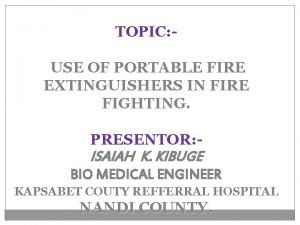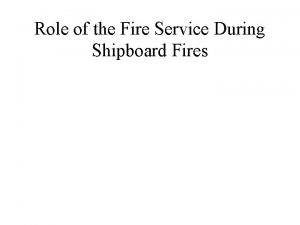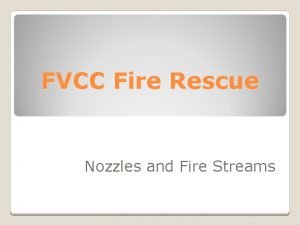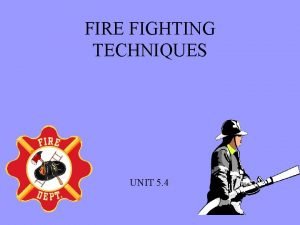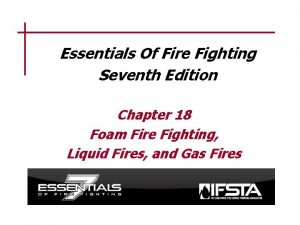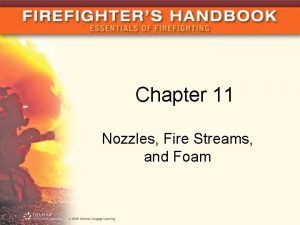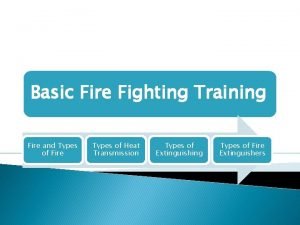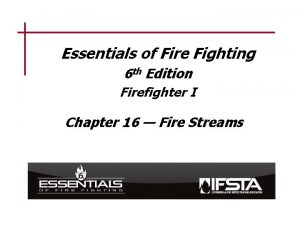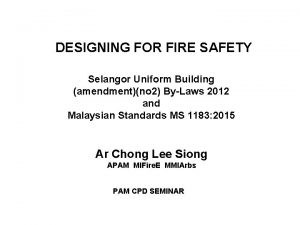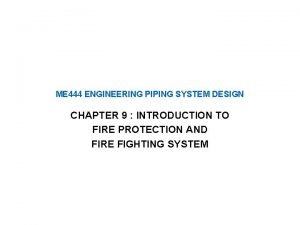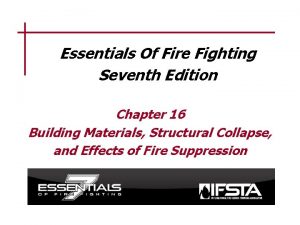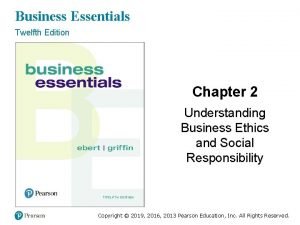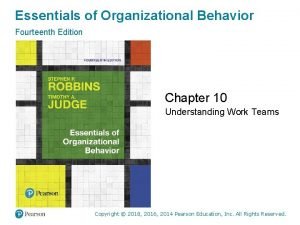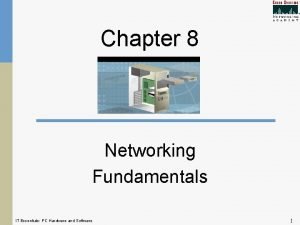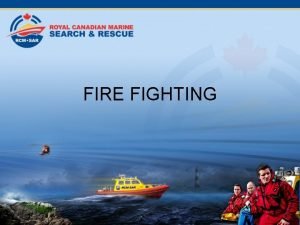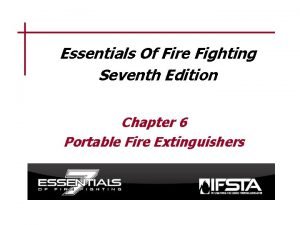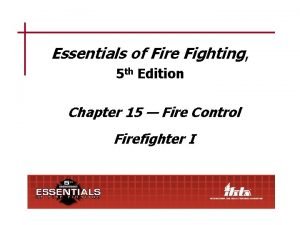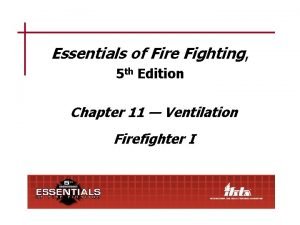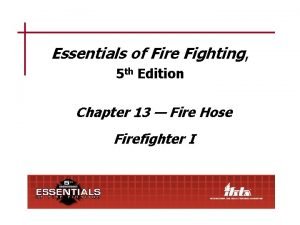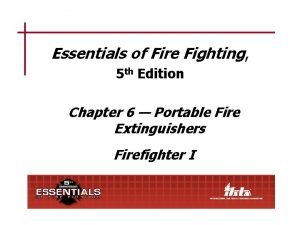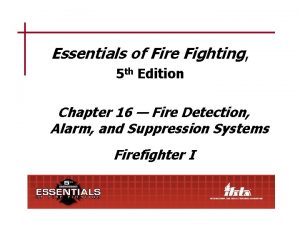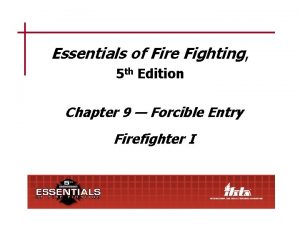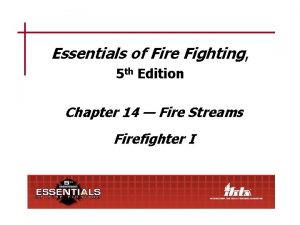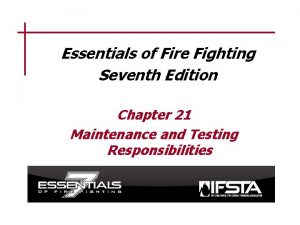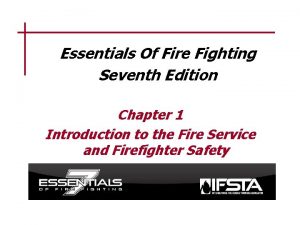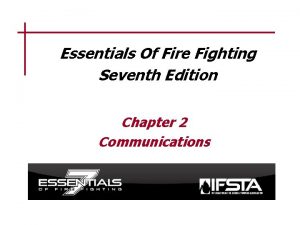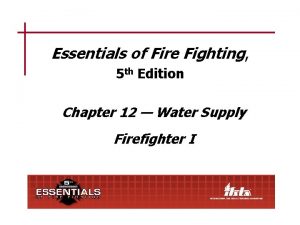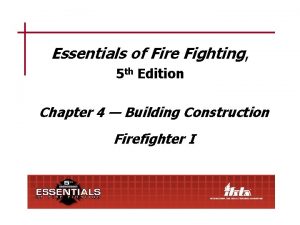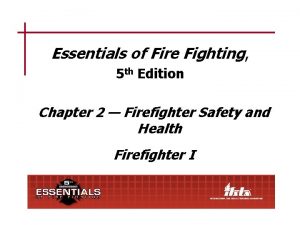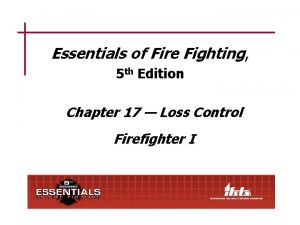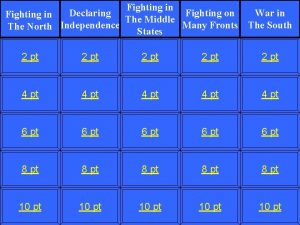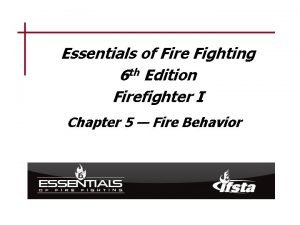Essentials of Fire Fighting 5 th Edition Chapter






































































- Slides: 70

Essentials of Fire Fighting, 5 th Edition Chapter 7 — Ropes and Knots Firefighter I

Chapter 7 Lesson Goal • After completing this lesson, the student shall be able to apply basic use of ropes and knots following the policies and procedures set forth by the authority having jurisdiction (AHJ). Firefighter I 1

Specific Objectives 1. Compare and contrast the characteristics of life-safety rope and utility rope. 2. Summarize criteria for reusing life-safety rope. 3. Describe rope materials. (Continued) Firefighter I 2

Specific Objectives 4. Describe types of rope construction. 5. Summarize basic guidelines for rope maintenance. 6. Explain procedures for storing life-safety rope. 7. Describe webbing and webbing (Continued) construction. Firefighter I 3

Specific Objectives 8. Describe parts of a rope and considerations in tying a knot. 9. Describe knot characteristics and knot elements. 10. Describe characteristics of knots commonly used in the fire service. (Continued) Firefighter I 4

Specific Objectives 11. Select commonly used rope hardware for specific applications. 12. Summarize hoisting safety considerations. 13. Discuss rescue rope and harness. 14. Inspect, clean, and store rope. (Continued) (Skill Sheet 7 -I-1) Firefighter I 5

Specific Objectives 15. Coil and uncoil a rope. (Skill Sheet 7 -I -2) 16. Tie the single overhand knot. (Skill Sheet 7 -I-3) 17. Tie a bowline. (Skill Sheet 7 -I 4) 18. Tie a clove hitch. (Skill Sheet 7(Continued) I-5) Firefighter I 6

Specific Objectives 19. Tie a clove hitch around an object. (Skill Sheet 7 -I-6) 20. Tie a figure eight. (Skill Sheet 7 -I-7) 21. Tie a figure-eight bend. (Skill Sheet 7 -I-8) 22. Tie a figure eight on a bight. (Continued) (Skill Sheet 7 -I-9) Firefighter I 7

Specific Objectives 23. Tie a becket bend. (Skill Sheet 7 -I-10) 24. Hoist an axe. (Skill Sheet 7 -I 11) 25. Hoist a pike pole. (Skill Sheet 7 I-12) 26. Hoist a roof ladder. (Skill Sheet 7 -I-13) (Continued) Firefighter I 8

Specific Objectives 27. Hoist a dry hoseline. (Skill Sheet 7 -I 14) 28. Hoist a charged hoseline. (Skill Sheet 7 -I-15) 29. Hoist a power saw. (Skill Sheet 7 -I-16) Firefighter I 9

Life-Safety Rope • Used to support rescuers and/or victims during actual accidents or training • Must conform to NFPA® 1983 • Must be block creel construction using continuous filament virgin fiber for loadbearing elements Firefighter I 10

Utility Rope • Used in instances where rope is required but not used to support rescuer/victims • Industry standards exist concerning physical properties • No standards for applications • Regularly inspect for damage Firefighter I 11

NFPA® 1983 • Rope manufacturers must supply purchasers with information about – Use criteria – Inspection procedures – Maintenance procedures – Criteria for retiring life-safety rope from service (Continued) Firefighter I 12

NFPA® 1983 • Criteria to consider before life-safety rope is reused in life-safety situations – Must not be visibly damaged – Must not show abrasions or have been exposed to high temps/direct flame contact – Has not been impact loaded (Continued) Firefighter I 13

NFPA® 1983 • Criteria to consider before life-safety rope is reused in life-safety situations – Must not have been exposed to any substance that can deteriorate rope – Must pass inspection made by qualified person before AND after use Firefighter I 14

Removing Life-Safety Rope From Service • Life-safety rope that fails to pass inspection or has been impact loaded should be destroyed immediately • Destroy = Altered in such a manner that it cannot be mistaken for life-safety rope (Continued) Firefighter I 15

Removing Life-Safety Rope From Service • Rope subjected to impact loading must have entry made in log because there is no way to determine by inspection if it has been impact loaded Firefighter I 16

Natural Fiber Rope • Primary type of rope used for rescue until last half of 20 th century • Most made of hemp or cotton Courtesy of Blue. Water Ropes (Continued) Firefighter I 17

Natural Fiber Rope • No longer accepted in life-safety applications • Can be used for utility purposes • Made of short overlapping strands of fiber Firefighter I 18

Synthetic Rope • Preferred for life-safety applications • Excellent resistance to mildew and rotting, excellent strength, easy to maintain • May feature continuous fibers running entire length of rope (Continued) Firefighter I 19

Dynamic Rope • Used when long falls are possible • Designed to stretch without breaking • Elasticity a disadvantage when raising/lowering heavy loads • Not practical for rescue or hauling applications Firefighter I 20

Static Rope • Used for most rope-rescue incidents • Low stretch without breaking • According to NFPA® 1983, must not elongate more than 10 percent when tested under load equal to 10 percent of breaking strength • Used for rescue, rappelling, hauling Firefighter I 21

NFPA® 1983 Light Use Rope • ⅜-inch (9. 5 mm) diameter or greater, less than ½-inch (12. 5 mm), intended to support one person’s weight • Minimum breaking strength of 4, 500 pounds (20 k/N) • Maximum safe working load limit of 300 pounds (136 kg) Firefighter I 22

NFPA® 1983 General-Use Rope • 7/16 -inch (11 mm) diameter or greater, less than or equal to ⅝-inch (16 mm), intended to support two persons • Minimum breaking strength of 9, 000 pounds (40 k/N) • Maximum safe working load limit of 600 pounds (272 kg) Firefighter I 23

NFPA® 1983 Throwline • 19/64 -inch (7 mm) diameter or greater, but less than 3/8 -inch (9. 5 mm), used to tether rescuers during water rescues or to throw to victim in water • Minimum breaking strength of 3, 000 pounds (13 k/N) • Maximum safe working load limit of 200 pounds (91 kg) Firefighter I 24

NFPA® 1983 Escape Rope • Not life-safety or utility rope; constructed in same manner as lifesafety rope • Must meet generally the same requirements as throwline • Intended to be used only one time then destroyed Firefighter I 25

Common Rope Construction • Kernmantle rope Courtesy of Blue. Water Ropes • Laid (twisted) natural or synthetic rope Courtesy of Blue. Water Ropes Firefighter I 26 (Continued)

Common Rope Construction • Braided rope Courtesy of Blue. Water Ropes • Braid-on-braid rope (double braid) Courtesy of Blue. Water Ropes Firefighter I 27

General Rope Maintenance Guidelines • Inspect all types after each use • Unused should be inspected at least annually • Inspect visually and by touch • Inspect foreign objects; if found, take out of service • All inspections documented in log Firefighter I 28

Types of Rope — Maintenance • • Kernmantle rope Laid rope Braided rope Braid-on-braid rope Firefighter I 29

Maintaining Rope Log • When rescue rope is purchased, it must be permanently identified • Record must be started and kept throughout rope’s working life Firefighter I 30

Cleaning Rope • Methods vary by manufacturer; contact for specific instructions • Natural fibers • Synthetic fibers Firefighter I 31

General Rope Storage Considerations • Can be stored in coils or rope bags • Should be stored in clean, dry spaces with adequate ventilation • Not exposed to chemical contaminants • Not stored in same space with gasolinepowered tools, spare fuel (Continued) Firefighter I 32

Bagging Rope • Best method for life-safety rope is to place in storage bag • Bag makes rope easy to transport, protects rope from contamination • Advantage of storing synthetic rope in bag is that rope can be deployed quickly (Continued) Firefighter I 33

Bagging Rope • Weight of the rope inside bag carries it toward target and rope pays out as bag travels through air • Bag may have drawstring and shoulder straps for ease in carrying Firefighter I 34

Coiling/Uncoiling Rope • Coiling necessary so rope may be placed into service with minimum delay important in fire service • Improperly coiled rope may become tangled and fail to uncoil Firefighter I 35

Webbing • Often used in conjunction with ropes • Most made from same materials as synthetic rope; same precautions, maintenance procedures apply • Size needed varies with intended use Firefighter I 36

Types of Webbing Construction • Two designs — One solid, flat; other tubular • Both look the same unless viewed at ends • Tubular is of two designs: spiral and chain weave • Spiral stronger, more resistant than chain Firefighter I 37

Parts of Rope • Running end — Free end used for hoisting, pulling, belaying • Working end — End tied to object being raised, lowered, stabilized • Standing part — Section between working end and running end Firefighter I 38

Knot-Tying Considerations • Knots are used to join or connect ropes or webbing, form loops in ropes or webbing or attach ropes or webbing to objects • Should be dressed after tied • Even properly dressed knots can fail Firefighter I 39

Knot Characteristics • To be suitable for rescue, must be easy to tie and untie, be secure under load, reduce rope’s strength minimally • Rope’s strength reduced whenever bent • Bight, loop, round turn — Bends in rope • Knots, hitches formed by combining bending elements Firefighter I 40

Knot Elements • Bight — Formed by bending rope back on itself while keeping sides parallel (Continued) Firefighter I 41

Knot Elements • Loop — Made by crossing side of bight over standing part (Continued) Firefighter I 42

Knot Elements • Round turn — Consists of further bending one side of loop Firefighter I 43

Commonly Used Knots • Single/double overhand safety knots – Can be used when tying any type of knot – Best to provide highest level of safety – Use eliminates danger of end of rope slipping back through knot and causing failure (Continued) Firefighter I 44

Commonly Used Knots • Bowline – One of the most important in fire service – Easily tied, untied; good forming single loop that will not constrict object it is placed around – Firefighters should be able to tie in the open as well as around objects (Continued) Firefighter I 45

Commonly Used Knots • Half-hitch – Particularly useful in stabilizing tall objects being hoisted; always used with another knot or hitch – Formed by making round turn around object – Several can be applied in succession if required (Continued) Firefighter I 46

Commonly Used Knots • Clove hitch – May be formed by several methods – Highly susceptible to failure – May be formed anywhere in rope – Withstands steady pull in either direction – May need to be backed up with overhand safety knot (Continued) Firefighter I 47

Commonly Used Knots • Figure-eight family of knots – Figure eight – Figure-eight bend – Figure eight on a bight – Figure-eight follow through (Continued) Firefighter I 48

Commonly Used Knots • Becket bend (sheet bend) – Used for joining two ropes of unequal diameters or joining rope and chain – Unlikely to slip when rope is wet – Advantages make it useful, dependable in fire service rope work – Not suitable in life-safety applications (Continued) Firefighter I 49

Commonly Used Knots • Water knot – Preferred knot for joining two pieces of webbing or ends of same piece when loop needed – Formed by tying simple overhand knot in one piece or end and following through in reverse direction with another piece or end Firefighter I 50

Commonly Used Hardware • Carabiner • Figure-eight plate (descender) (Continued) Firefighter I 51

Commonly Used Hardware • Brake bar rack (descender) • Ascender (Continued) Firefighter I 52

Commonly Used Hardware • Pulleys Firefighter I 53

Using Rope for Hoisting • One of most common uses of rope in fire service — Raise or lower tools and pieces of equipment from one elevation to another • Thorough knowledge of knots, hitches makes this a safe, efficient practice (Continued) Firefighter I 54

Using Rope for Hoisting • Anything with closed-type D-ring handle can be raised, lowered with bowline or figure-eight bend • Hoisting pressurized cylinders not recommended (Continued) Firefighter I 55

Using Rope for Hoisting • Using proper knots, securing procedures helps prevent dropping of equipment • Separate guideline may be tied to any of these pieces of equipment; objects may also be tied in center of rope Firefighter I 56

Hoisting Safety — General • Have solid footing, make necessary preparations beforehand • Use hand-over-hand method • Use edge roller or padding • Work in teams (Continued) Firefighter I 57

Hoisting Safety — General • Look to ensure all personnel clear of hoisting area • Avoid hoisting operations near electrical hazards • Secure nozzles of charged hoselines • Use guideline to help control object being hoisted Firefighter I 58

Hoisting Safety • Hoisting – Axe – Pike pole – Ladder – Hoselines – Portable fans – Power saw Firefighter I 59

Rescue Rope • Used when victims located above, below grade and need to be rescued • Technical skill that requires specialized training • Used for variety of purposes Firefighter I 60

Rescue Harness • Three classes – Class III Firefighter I 61

Summary • Rope is one of the oldest and most basic tools used by firefighters. It is used to stabilize vehicles and other objects, hoist tools and equipment aloft, and to allow firefighters to access and rescue victims who are stranded above or below grade, or in bodies of water. (Continued) Firefighter I 62

Summary • Rope is also used to help firefighters escape from life-threatening situations. (Continued) Firefighter I 63

Summary • To use rope safely and effectively during fires and rescue operations, firefighters must know the various types of rope and their applications. They must also be capable of tying a variety of knots and hitches quickly and correctly — and that takes practice. (Continued) Firefighter I 64

Summary • Firefighters must know how to inspect, clean, and store ropes so that they are ready for use when needed. Firefighter I 65

Review Questions 1. What is the difference between life-safety rope and utility rope? 2. List three criteria that life-safety rope must meet before it is reused in life-safety situations. (Continued) Firefighter I 66

Review Questions 3. Why is synthetic rope preferred for life-safety situations? 4. What two types of rope are used in life-safety situations? 5. Describe the most common types of rope construction. (Continued) Firefighter I 67

Review Questions 6. How should the following types of rope be inspected: kernmantle rope, laid rope, braided rope, and braid-on-braid rope? 7. What are general guidelines for cleaning synthetic fiber rope? (Continued) Firefighter I 68

Review Questions 8. What are the elements of a knot? 9. Describe commonly used rope hardware. 10. List four safety considerations for hoisting tools and equipment. Firefighter I 69
 Business essentials 12th edition chapter 1
Business essentials 12th edition chapter 1 Class a combustible material
Class a combustible material Shipboard fire fighting organization
Shipboard fire fighting organization Broken stream fire fighting
Broken stream fire fighting Siphip
Siphip Nstm 555 2021
Nstm 555 2021 At a bulk transport incident firefighters must
At a bulk transport incident firefighters must Solid-stream nozzle in fire fighting
Solid-stream nozzle in fire fighting Fire fighting methods
Fire fighting methods Foam pro 1600
Foam pro 1600 Firefighter motto
Firefighter motto Tactical ventilation
Tactical ventilation Rotary control valve firefighting
Rotary control valve firefighting Uniform building by-law malaysia latest
Uniform building by-law malaysia latest New age fire fighting company dubai
New age fire fighting company dubai Sprinkler temperature color code
Sprinkler temperature color code Network security essentials 5th edition pdf
Network security essentials 5th edition pdf Essentials of investments 11th edition
Essentials of investments 11th edition Business essentials 12th edition answer key
Business essentials 12th edition answer key Essentials of sociology 5th edition
Essentials of sociology 5th edition Firefighter essentials 7th edition
Firefighter essentials 7th edition Business essentials 12th edition
Business essentials 12th edition Voyage estimating decision support system
Voyage estimating decision support system Types of group
Types of group Cryptographic systems are generically classified by
Cryptographic systems are generically classified by Criminal justice the essentials 5th edition
Criminal justice the essentials 5th edition Chapter 40 fighting the cold war at home
Chapter 40 fighting the cold war at home Using mis (10th edition) 10th edition
Using mis (10th edition) 10th edition Chapter 1
Chapter 1 Neo luddite criticisms of computer technology
Neo luddite criticisms of computer technology A gift of fire 4th edition
A gift of fire 4th edition Reichstag fire who was the fire starter
Reichstag fire who was the fire starter Damper fire alarm
Damper fire alarm Uttar pradesh fire prevention & fire safety rules, 2005
Uttar pradesh fire prevention & fire safety rules, 2005 Ire fire fire rwi
Ire fire fire rwi Fire definition
Fire definition It essential chapter 8
It essential chapter 8 What are the 10 essentials of a successful ffa chapter
What are the 10 essentials of a successful ffa chapter It essentials chapter 9
It essentials chapter 9 It essential chapter 14
It essential chapter 14 Chapter 12 quiz it essentials
Chapter 12 quiz it essentials It essentials chapter 11
It essentials chapter 11 Marketing essentials chapter 38
Marketing essentials chapter 38 Merchandise approach method
Merchandise approach method In what way is marketing related to form utility
In what way is marketing related to form utility It essentials chapter 5
It essentials chapter 5 It essentials chapter 3
It essentials chapter 3 It essentials chapter 11
It essentials chapter 11 Essentials of social media marketing chapter 9 quiz
Essentials of social media marketing chapter 9 quiz It essentials chapter 7
It essentials chapter 7 It essentials chapter 6
It essentials chapter 6 It essentials chapter 5
It essentials chapter 5 It essentials chapter 4
It essentials chapter 4 Chapter 4 kitchen essentials 1 answers
Chapter 4 kitchen essentials 1 answers It essentials chapter 2
It essentials chapter 2 It essential chapter 5
It essential chapter 5 Pata cable
Pata cable It essentials chapter 10
It essentials chapter 10 It essentials chapter 10
It essentials chapter 10 Ad altare dei answers chapter 1
Ad altare dei answers chapter 1 Marketing essentials chapter 2
Marketing essentials chapter 2 It essentials chapter 4
It essentials chapter 4 It essentials chapter 7
It essentials chapter 7 What are the ten essentials of a successful ffa chapter
What are the ten essentials of a successful ffa chapter It essentials chapter 8
It essentials chapter 8 It essentials chapter 6
It essentials chapter 6 _______is considered as moist method of cooking.
_______is considered as moist method of cooking. It essentials chapter 13
It essentials chapter 13 When fighting fires a firefighter must use great caution
When fighting fires a firefighter must use great caution What advice does the nurse give juliet
What advice does the nurse give juliet Israeli fighting system
Israeli fighting system

